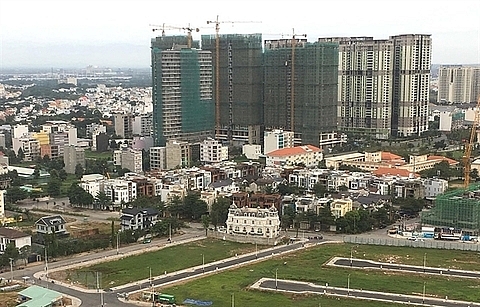Gov’t takes tighter control over large-size real estate projects
 |
| Real estate loans accounted for 19.14 per cent of the total outstanding loans as of September 30.-VNA/VNS Photo |
The SBV meanwhile is also required to monitor real estate firms or realty projects with outstanding loans of more than VND1.5 trillion (US$64.56 million).
According to SBV’s data, as of September 30, credit had risen by 9.4 per cent against the end of 2018, focusing on production and business activities. Meanwhile, credit for high-risk sectors, mainly the real estate sector, has been tightly controlled.
Real estate loans accounted for 19.14 per cent of the total outstanding loans, up 14.58 per cent against the figure seen in late 2018. The growth rate was higher than the 9.4 per cent average credit growth of the economy.
According to the SBV, real estate credit surged over the past few months of 2019 due to the Government’s change in calculations. In the past, loans for real estate firms and consumer credit for house buyers were placed into separate categories. However, since last year, the two indicators have been merged into one for more accurate measurement of credit growth in the sector, leading to the surge in property credit figures.
Of the total loans in the first nine months of this year, loans for real estate business activities represented 32.7 per cent of the sector’s outstanding loans, up 5.5 per cent.
Consumer credit made up 20.7 per cent of the total outstanding loans in the economy, up 13.9 per cent, of which loans for activities associated with the real estate sector, including buying, renting, building or repairing houses, accounted for 59.4 per cent of the total outstanding consumer loans, soaring 19.5 per cent.
What the stars mean:
★ Poor ★ ★ Promising ★★★ Good ★★★★ Very good ★★★★★ Exceptional
Related Contents
Latest News
More News
- Green finance offers 'passport' for Vietnamese construction, building materials firms (December 15, 2025 | 08:00)
- Gamuda Land commit long-term investment (December 12, 2025 | 11:49)
- HITC ties up with Evolution to develop AI and hyperscale data centres in Vietnam (December 11, 2025 | 12:09)
- Real estate deals boom via high-profile names (December 08, 2025 | 11:32)
- Industrial segment shaped by M&As (December 08, 2025 | 08:00)
- The Privé sets the benchmark for luxury real estate (December 05, 2025 | 08:28)
- TD CASA and the rise of bespoke interior design in luxury living spaces (December 03, 2025 | 14:14)
- Lee Soo-man's Blooming Sky to build Gia Lai culture, sport, and entertainment complex (December 02, 2025 | 16:41)
- Sustainability in DNA of Keppel Vietnam's future urban development strategy (November 28, 2025 | 10:53)
- South Korean investors seek clarity on IP lease extensions (November 24, 2025 | 17:48)

 Tag:
Tag:
















 Mobile Version
Mobile Version